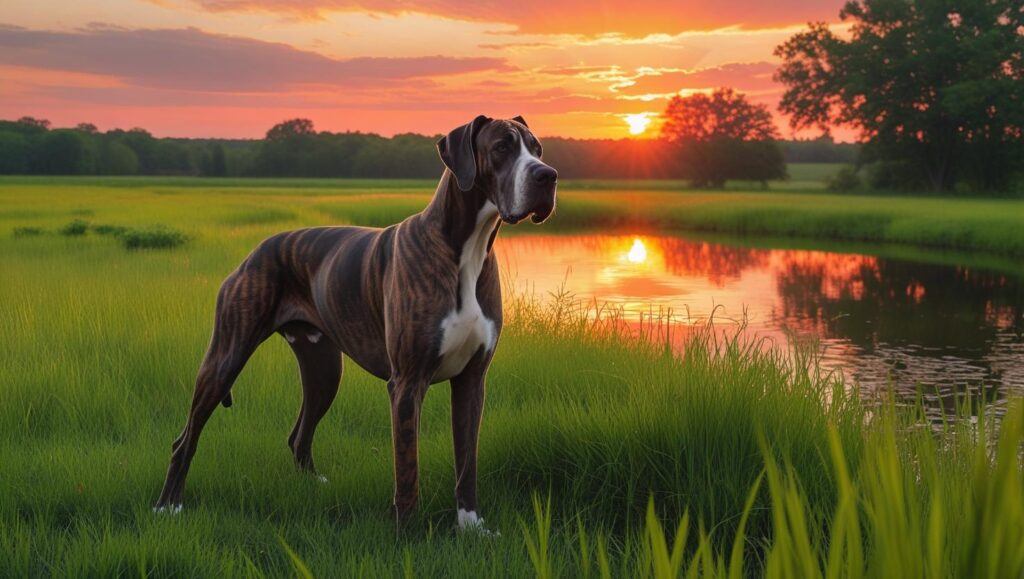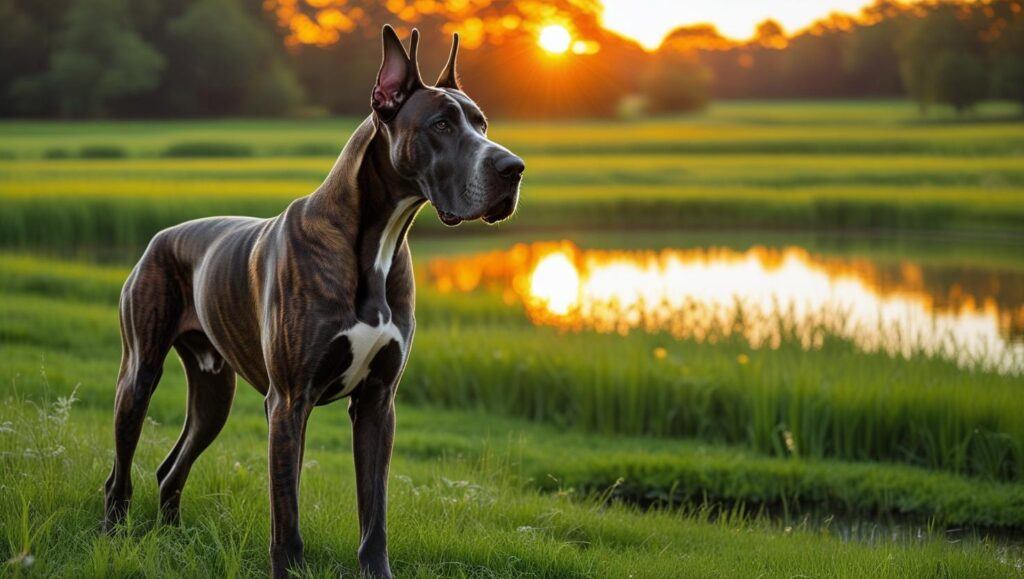
The tale of the Great Dane is as grand as the dog itself. Originally bred as boar-hunters in Germany, these gentle giants have evolved from their fierce hunting days to become loving family companions. Their lineage is said to date back to ancient times, suggesting that the Great Dane has always been held in high regard.
When you meet a Great Dane, their physical presence can be quite a statement. Towering over most dogs, a male can tip the scales at over 180 pounds, while females aren’t far behind. Despite their massive size, they move with a surprising grace. Their coats are sleek and come in several colors, like fawn, brindle, and even a striking blue.
Now, don’t let their size fool you—they’re as gentle as they come. Known for their loving nature and affectionate demeanor, Great Danes often think of themselves as lap dogs, regardless of their bulk. Their temperament is characterized by an even-keeled disposition and soft hearts. It’s no wonder they’re often tagged as ‘gentle giants.’
But why the nickname? Simple. It captures their essence—a blend of strength and gentleness. Great Danes embody the idea of a steadfast companion, standing tall not just in stature but in loyalty and love. Understanding them means appreciating a breed that brings companionship and elegance into their families’ lives.
Caring for Your Great Dane: Essential Tips for First-Time Owners
Taking care of a Great Dane might seem like a big task, but with the right tips, it becomes less daunting. The first step in being a responsible owner is understanding their dietary needs. A balanced diet is crucial, focusing on high-quality dog food that supports their energy and growth. Overfeeding is a common concern, so keeping those portion sizes just right helps avoid health issues later on.
Now, let’s talk movement. Great Danes love to stretch their long legs, but they’re not endurance athletes. Short, daily walks coupled with some playtime in a fenced yard usually does the trick. Be mindful, though, of their joints and bones—especially while they’re still growing. Too much strenuous activity can be harmful during their formative months.
Health is a priority—Great Danes are known for a few specific ailments like hip dysplasia and bloat. Knowing the signs to watch out for and having a vet familiar with the breed can save you from future headaches. Make sure regular check-ups and vaccinations are part of your routine to keep them in tip-top shape.
Even though they come with a low-maintenance coat, a little grooming effort goes a long way. Weekly brushing helps manage shedding, while regular nail trims and ear cleaning should become a part of their grooming schedule. It’s these small steps that keep your Great Dane looking and feeling their best.
Building a Bond: Training and Socializing Your Great Dane
Training a Great Dane is all about patience and consistency. Start with basic commands like sit, stay, and come. Their size can be intimidating, so leash training early on can prevent future chaos during walks. Short, positive training sessions work best, using rewards and praise to reinforce good behavior.
Socialization is key to having a well-rounded Great Dane. From a young age, expose them to different environments, people, and other pets. Visits to dog parks or trips around the neighborhood let them learn how to interact positively in various situations. A well-socialized Dane is usually more confident and less fearful of novel experiences.
Sometimes, Great Danes can develop behavioral quirks, so it’s important to address issues head-on. Common problems like jumping up on people or barking excessively should be managed with redirection techniques and consistency. Seek guidance from professional trainers if needed; they can offer tailored strategies for your pup.
Creating a nurturing environment sets the foundation for your Great Dane’s development. Provide plenty of mental stimulation through toys and games, and ensure they have their own space to relax away from hustle and bustle when needed. A loving home goes a long way in building a strong, trusting bond with these gentle giants.
Living with a Great Dane: Integrating Them into Your Home and Family
A Great Dane is not just a pet; they’re a family member, and making room for them is part of the package. Start by setting up your home to accommodate their size. Think about sturdy furniture that can withstand a wagging tail and avoid cluttered spaces where they might accidentally knock things over.
It’s important to involve everyone in the household in the Dane’s life. Consistent rules and training commands across family members help prevent confusion and reinforce good behavior. Remember, big dogs require big love, and sharing the responsibility makes it rewarding for all.
When it comes to living harmoniously with children, supervision is the secret sauce. With their gentle nature, Great Danes are often great with kids, but teaching both the pup and the children how to interact respectfully creates a safe environment. Set boundaries and encourage gentle play on both sides.
Owning a Great Dane means embracing a long-term commitment filled with laughter, a few slobbers, and endless affection. They thrive on companionship, so ensure your lifestyle fits their needs for leisure and attention. By integrating your Dane fully into your life, you welcome not just a pet, but a loyal friend who truly becomes part of the family.
